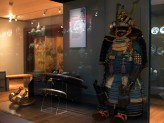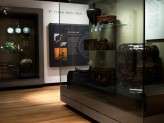Room 37 | Japan 1600-1850 gallery
Discover the arts of the Edo period (1600-1868) from porcelain to lacquer to painting.

Introduction
Great Peace throughout the Realm
After over a century of fierce civil wars between rival samurai lords, Japan was unified in the early 1600s under the Tokugawa family of military rulers. For the next 250 years Japan was at peace, with the Tokugawa shoguns ruling from their capital Edo (modern Tokyo).
During the Edo period (1600-1868), the arts flourished under the patronage of high-ranking samurai and the imperial court. Wealthy merchants also became important patrons of the arts.
The period saw the beginnings of porcelain production, the appearance of new schools of painting and the blossoming of woodblock printing. There were also striking developments in lacquerware, metalwork, textile design, and the arts of the tea ceremony.
Notice
Objects may have since been removed or replaced from a gallery. Click into an individual object record to confirm whether or not an object is currently on display. Our object location data is usually updated on a monthly basis, so contact the Jameel Study Centre if you are planning to visit the museum to see a particular Eastern Art object.
© 2013 University of Oxford - Ashmolean Museum



